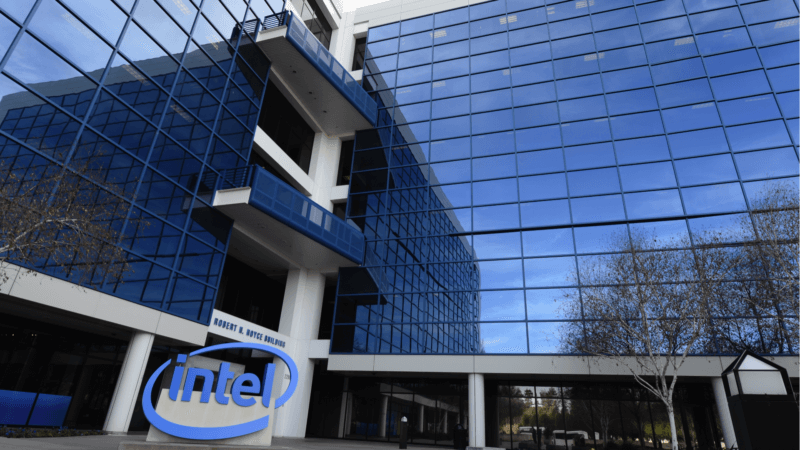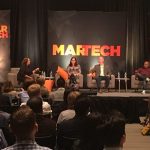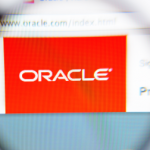How Intel uses real-life stories to build campaigns around its B2B technology solutions
As VP of global marketing and communications for Intel’s B2B marketing strategy, Alyson Griffin is taking technology-focused marketing to a new level.

When Alyson Griffin took over Intel’s B2B marketing strategy in July of 2016, the technology brand had been focusing its dollars and resources on its consumer marketing and PC marketing.
“The marketing before July of 2016 was ecosystem marketing — and what I mean when I say that, is the people who would buy our chips from us and incorporate them into a product that then gets sold somewhere else,” says Griffin. She says Intel eventually realized its opportunity for real growth was not just in PCs but was on the data-center side of the business.
“Specifically, Xeon processors, but also storage, memory, fabric, network, things like that,” says Griffin, “At first, it was thought that we’re known, we’re Intel — B2B servers — our market segment share is in the 90th percentile, so why do we need to market?”
According to Griffin, Intel didn’t actually have strong brand leadership in the places where the company wanted to grow.
“We are new in some of the areas, we are a challenger in some of the areas, and in some areas we are completely unknown. And to establish what our role is in artificial intelligence or autonomous driving are good examples of those.”
Griffin says her goal is to drive the marketing strategies to build Intel’s brand within the B2B landscape. Most recently, her team has been building campaigns around initiatives like Intel’s AI technology and the company’s membership with New Lab, a warehouse space in Brooklyn that provides workspace and resources for a community of technology-focused entrepreneurs.
In today’s interview, the VP of global marketing and communications for Intel’s B2B marketing strategy shares how the brand is using real-life stories to build out marketing campaigns around its complex technology solutions and the technology she is most excited about sharing with the world.

Alyson N. Griffin
VP of Global Marketing & Communications, B2B Marketing Strategy @ Intel
Amy Gesenhues: What are you aiming to deliver as a ‘brand experience’ around things like Intel’s AI technology?
Alyson Griffin: At the core of the brand, we’re talking about how companies can — with Intel’s help and technology expertise solutions — transform, and that transformation can take place for profit, it can take place for non-profit, for good in the world, for many ways.
We’re trying to use that overall umbrella brand campaign to show that we’re relevant, and here, and have solutions, ideas and technology leadership to help businesses do all those things that they want to do. The campaign tagline is, “We know the future because we’re building it.” I like to say a technology doesn’t exist in the world unless an Intel innovator, a guy in a lab somewhere, thought of it 10 years ago.
The campaign brings to life the possibilities and the things and the innovations we’ve thought of in order to enable different experiences out there in the world.
AG: How do you build a campaign around a technology solution like AI without getting lost in the complexities of the technology itself?
Allyson Griffin: I’ll give you one of my favorite examples. It is for a company called Snotbot (and I did say snot, as in what would come out of your nose). They have very innovative conversation with a marine biologist [Dr. Iain Kerr] and his lifelong work of tracking humpback whale colonies, and specifically, the importance of the oceans and the whales and what the whales can tell us. Basically acting as a barometer for health of the water, which tells you ozone effects, as well as health of the fish — which then can tell you health of humanity.
The way to do that research was very labor-intensive, very costly and very time-consuming. You would take a boat, chase whales around, the boat would have to get super-close, which the whales didn’t like. They would swim away if the boats got too close. Then the researchers would have to harpoon and take flesh and sample it. It was distressing.
Now, we’ve been working with him, and we send drones out to fly over humpback whale colonies in the wild from a nice safe distance. The drones are outfitted with sterile collection cups. When the whale does his blowhole, we collect the snot, or DNA, and then the drone flies that sample back to the boat.
You can do this many, many, many, many times very quickly. You don’t just get one whale, you can get hundreds of whales in one expedition. And the drone is also, in addition to collecting snot, outfitted with Movidious (computer vision). It’s getting visuals, all that data being downloaded in real time onto the ship. And then, of course, artificial intelligence algorithms to analyze and make predictions about those important areas.
That’s just one interesting thing, and a good example. What I’m trying to do with the overall business transformation campaign is not only have data center administrators stand in front of a rack of servers and talk about 30 percent more efficiency; I’d rather talk about Dr. Iain Kerr and the struggle he had with a very low-tech field — and how our technology was able to catapult his research extraordinarily, and in an innovative way.
AG: Can you share more about the New Lab membership Intel announced in July of 2017?
Alyson Griffin: New Lab is just fascinating to me. I love the vision of what they’re doing there overall.
It’s a Brooklyn Navy Yard, a shipyard — total reconstruction of a hangar. It houses 94 companies the last I checked, and they’re growing all the time. In fact, they’re bursting at the seams, and they’re taking over another hangar in the Navy yard.
What they’re doing is attracting startups that are through their funding stages, have worked out the kinks and actually have real product in-market with customers. The kinds of companies they’re attracting are mostly (when I say mostly, I mean 90 percent) around artificial intelligence, IoT, maybe endpoint devices, analytics, cloud and robotics — so really interesting profiles of what innovative young companies are thinking about.
It gives Intel a front-row seat to the future. Uber snuck up, Netflix snuck up, those kinds of companies — that’s how I see New Lab. They’re the next of those innovative, game-changing technologies. I can’t imagine life without either Netflix or Uber, to be honest. And many years ago, I couldn’t even have imagined life with it.
These great startups are doing very complex technical and interesting things. There are so many varieties of what they’re doing there, many of which are trying to do good in the world, which is the profile of this age of millennial who’s doing these startups. They’re millennial technically, but they’re older millennial — and they definitely have that millennial spirit and vibe about them.
AG: What do you mean by millennial vibe?
Alyson Griffin: I can give you an example. StrongArm Technologies is a group of guys — their backstory is fascinating. The founder and CEO’s father was in construction, and he grew up blue-collar in the New York area. The father was in an accident, an industrial accident, and ultimately died. The founder, Sean, was quite young when that happened, and it really affected him.
When he went to college, he decided to become an engineer and realized that his purpose was to help the industrial athlete. He created an exoskeleton that is fitted with Intel sensors and backed by a bunch of very sophisticated algorithms and machine learning — deep learning and prediction — to outfit the industrial athlete.
For example, a guy’s bending over loading a pallet all day every day. The sensors and the modeling can say, “We know that on the fourth day, his back is so weak that it can snap, so it’s a greater risk of injury. After three days of pallet stacking, we are going to move him to the forklift, where he’s sitting, and he’s not raising, picking up boxes, and it saves his back.”
There’s lots of benefits, but the focus for StrongArm is first and foremost to the industrial athletes themselves. Their customers are big names that you absolutely would know, with delivery and warehousing and things like that. Their customers can save on workers’ comp claims, be more efficient, not have guys calling in sick. Because this guy is using IoT in a sensor device mapped to machine learning and artificial intelligence, his customers are able to gain significant advantage in how they plan their workforce.
AG: What have you found to be the biggest challenges when building campaigns around technology like AI?
Alyson Griffin: AI is really interesting. It is a challenge, and it means different things to different people in different parts of the world.
AI has the reputation that robots are going rise up and kill you in your sleep, right? Very scary. What we want to do in our marketing, especially around AI, is a program I call “AI for good.” We’re trying to demonstrate and show all the ways AI is being used for human benefit. The Snotbot example is one, the exoskeleton could be one, but there are several others we’ve been marketing.
It’s to your point, give an example that people can understand — I can understand that if whales are sick and fish are sick, and I eat that fish, I could die. It’s not a techie-type story. We’re trying to find these really interesting stories.
Another example of AI for good is the Center for Missing and Exploited Children. It’s in Washington, DC, a non-profit, and we have a bunch of Intel technology powering the computer, as well as all artificial intelligence that’s required for their tip line for missing children or exploited children.
You could imagine if humans were trying to keep track of the emails and phone calls and walk-ins, and whatever tips they get on children, or things they think are shady. It takes a really long time to figure out: Is this legit? Did I get it? Do I understand it? Where would it be? Which police forces would I deploy to go check it out?
They were getting millions of tips on their tip line. Now, with the automated process, the computer power from Intel and facial recognition, they know where that child is. They are now able to address issues in days or weeks versus months. Their success rate of saving children has grown exponentially.
They can transform what they do, what they offer and how they engage with the police force because we were able to deploy this AI solution for them.
AG: Has there ever been a time you feared you were taking a risk by building a campaign around how the technology is being used versus the technology itself?
Alyson Griffin: There hasn’t been one yet. We have KIPs, and our campaigns are significantly above norms. It’s not to say that perhaps something didn’t work exactly the way we wanted it to.
I have a high tolerance for reasonable risk, very high. So, trying this kind of stuff is a risk because most B2B marketers are talking about end user customer efficiency with a guy standing in front of a rack of servers. They’re not talking about exploited children or snot.
AG: Speaking of KPIs, what are you guys tracking around your campaigns and what martech are you using?
Alyson Griffin: We do use analytics, and of course, our analytics in our databases are only powered by Intel technology. We do lead nurturing, and we use Eloqua for that. And we do have a couple of technology stacks.
We are using the lead nurturing for retargeting and for optimizing once we know what our target is doing — or not doing — with the content and making recommendations based on the analytics of those campaigns.
We’re also using artificial intelligence — but not to the fullest extent of its meaning — to make predictions about how we need to change and optimize each of the initiatives moving forward. In the time I’ve been here, we’ve done that and we’ve been able to get clearer and crispier with our media agency for targeting. And we’ve been able to learn, if it’s email, is which headlines are working really well for us and which aren’t. Which assets are being clicked on and which require a media investment behind them to get any traction.
Those are the things that we’re looking at today.
AG: What are the primary marketing channels you are using for Intel’s B2B campaigns?
Alyson Griffin: I’ll tell you what we’re doing that, I think, may set us apart — it’s definitely not something Intel has done in the past. We are doing a content marketing strategy and placing content in the world where the target lives.
We use search, and yes, we have digital channels and syndicate content. But we’re trying to say, “Okay, I have a story around network transformation and the coming of 5G technology capabilities. I need to go reach network administrators out there.”
That’s super-niche, and my broad Intel channel isn’t where I’m going to get the biggest bang for my buck. I need to go where network administrators go, and place a white paper or a video. We did a virtual reality for a trade show storyline around just network transformation, and it was fantastic.
So, placing content where they live to get them to do something — opt in, engage with us, whatever — from where they are. Not necessarily buying or expecting that they’re coming to us or expecting that they’re following us on social.
“Light Reading,” for example, is a specific networking publication. It’s weird in that it’s not something anybody I know knows about, but it’s the bible for people in that industry. And so, the point is to go there and not place generic banners.
That’s the other big thing. I said, “No more generic banners.” Intel is leading technology. There is no spray-and-pray, click here and go to our very generic website, no way. You do a very purposely built piece for that network administrator. You place it where they are, and if it is driving them back to an Intel experience, then it’s going back to a specific business and network transformation experience where it pays off.
AG: What are you most excited about in all of Intel’s B2B technology offerings?
Alyson Griffin: I’m excited about telling a story that is relatively unknown in the world — that Intel has technology on the business side of the house. And it’s a challenge, because we’re overcoming arguably the best marketing campaign of all time: Intel Inside. It is a blessing and a curse — that’s what we’re known for.
We’re doing so many different things for different audiences, and the challenge is what excites me about being here — How am I going to tell a story that anyone’s going to give a rip about? And make it interesting?
I love AI, I love autonomous driving — and we have autonomous stuff that is not just cars, technology that I can’t even talk about yet, that we haven’t announced. I know it is going to be game-changing in the world. That’s the kind of stuff that makes me excited. That we have a very definitive role in defining the future, whether people realize it or not, and have the foundation already as a brand.
Marketing Land – Internet Marketing News, Strategies & Tips
(17)













